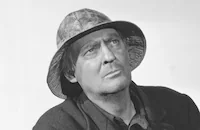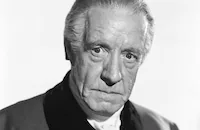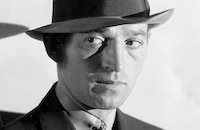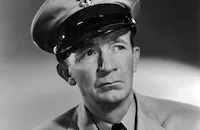Public Hero No. 1

Brief Synopsis
Cast & Crew
J. Walter Ruben
Lionel Barrymore
Jean Arthur
Chester Morris
Joseph Calleia
Paul Kelly
Film Details
Technical Specs

Synopsis
Sonny Black, a member of the notorious Purple Gang, which has been linked to a recent bank robbery and a child killing, shares his prison cell with Jeff Crane, an undercover Department of Justice operative who has been assigned to involve Sonny in a prison break in order to lead the FBI to the gangsters' hideout. After Sonny and Jeff hold up the prison board members, exchange clothes with them and walk out of the prison, a chase ensues, and Sonny is wounded by gunshot. In order to throw the police off his trail, Sonny instructs his fellow gangsters to create a diversion in another town by robbing a bank there. One night, while driving through a storm on his way to pick up Doctor Josiah Glass, an alcoholic physician who often treats wounded gangsters, Jeff accidentally runs an oncoming bus off the road and into the mud. He stops to help, but is soon pestered by the nagging Maria Theresa O'Reilly, a passenger on the disabled bus who, unknown to Jeff, is Sonny's estranged sister. After Theresa convinces Jeff to drive her into town, she flirts with him until he pays attention to her. She takes him to her room, and he discovers that she is Sonny's sister when he espies a picture of him in her suitcase. Theresa, who is looking for Sonny in order to get his signature on their uncle's inheritence papers, is taken to see him by Jeff. No sooner is Sonny reunited with his sister, than he slaps her for suggesting that he reform himself and return to serve out his prison term. Jeff witnesses the assault and punches Sonny to punish him for it. Later, Jeff cleverly tricks Doctor Glass into leading him to the gangster hideout by telling him that he is needed in an emergency and then feigning drunkenness, thereby forcing the doctor to drive them there. Once they arrive at the hideout, Jeff pulls a gun on the doctor and then calls Duff, his superior, to tell him that he has found the hideout. Before the FBI agents arrive, however, the gangsters return and a shootout ensues. Most of the gangsters are shot, but Sonny manages to escape and elude capture. One month after the shootout, Jeff discovers that all efforts to find Sonny have failed because the fugitive underwent reconstructive facial surgery that drastically altered his appearence. Though Jeff does not want to involve Theresa, with whom he has fallen in love, Duff insists that he use her to find Sonny. When taken to an FBI office for questioning, Theresa is shocked to learn that Jeff is a G-man. He apologizes for having deceived her and then tells her that he loves her. When efforts to find Sonny through Theresa fail because she does not know her brother's whereabouts, Jeff and Duff set a trap for Sonny by placing an ad in the paper requesting that he meet his sister at the Chicago theater at which she works if he is in need of cash. As predicted, Sonny shows up at the theater, and Theresa, unaware of the FBI trap, gives her brother the money as soon as he asks for it. Once the money is exchanged, the agents know who their man is. When the curtain comes down, Theresa spots the government agents waiting to capture Sonny, and she tries to warn him, but he is shot and killed while trying to escape. After Jeff is named "Public Hero Number One" for putting an end to the Purple Gang, he rushes to the train station and stops Theresa from leaving town so that they can resume their romance.

Director
J. Walter Ruben
Cast

Lionel Barrymore

Jean Arthur

Chester Morris

Joseph Calleia

Paul Kelly

Lewis Stone
Paul Hurst

George E. Stone
Sam Baker
John Kelly
Selmer Jackson
Lawrence Wheat
Cora Sue Collins
Lillian Harmer
Frank Mcglynn Jr.

James Flavin
Gladden James
Pat O'malley
Anderson Lawler
Norman Phillips Jr.
Frank Moran
John Hale

Walter Brennan
Richard Elliott
Russ Powell
Tammany Young

Arthur Housman
Landers Stevens
Carl Stockdale
Bert Roach
Greta Meyer
Zeffie Tilbury
Frank Darien
Ed Brady
Stanley Price

Helene Costello
Billy Sullivan
Crew
Lionel Banks
Bob Barnes
Hugh Boswell
William Brockway
Ed Garvin
Cedric Gibbons
Lucien Hubbard
Lloyd Isbell
W. B. Riley
W. B. Riley
Wells Root
Wells Root
J. Walter Ruben
Charles Ryan
Douglas Shearer
Bert Shipman
Frank Sullivan
Gregg Toland
Dolly Tree
Edward Ward
Edwin B. Willis
Robert Worl

Film Details
Technical Specs

Articles
Public Hero No. 1
By the mid 1930s Hollywood films began to move away from glorifying gangsters. The Production Code administrators, led by former Postmaster General Will H. Hays, decreed that films needed to help support the police and FBI in their fight against organized crime. A good example of this change is Public Hero No. 1 (1935), starring Lionel Barrymore, Jean Arthur, Chester Morris, Joseph Calleia, and Paul Kelly.
SYNOPSIS: A lawman (Chester Morris) poses as a convict and enters prison to spy on a noted gangster (Joseph Calleia in his first film role). When the gangster escapes, the lawman goes with him so he can find the rest of the gang. Jean Arthur stars as Calleia's sister who falls for Chester Morris and as the film progresses, her sympathies move from her brother to the lawman, as the public's sympathies would, too.
Shooting began at MGM on March 18, 1935 and ended only one month later. It proved to be a difficult shoot for Lionel Barrymore, who was going through personal problems. His wife, Irene, was losing her battle against anorexia and Barrymore was suffering what was believed to be crippling arthritis (although more recent books theorize that it was the after effects of syphilis). Within a few years, he would be confined to a wheelchair. The exhaustion was apparent. James Kotsilibas-Davis wrote in his book The Barrymores that a visitor to the set confused acting with real life. "Only a Barrymore could inject such realism into acting," noted a spectator during filming of a scene depicting Lionel sleeping on a couch. When the scene ended, the snoring continued, demonstrating that he had not been acting at all. The elder Barrymore was noted at his home studio for dropping off not only between scenes but often during their filming."
Andre Sennwald praised Public Hero No. 1 in his review in the June 8, 1935 New York Times, calling it "a rattling good show, equally effective in its snarling violence and in its humor....notable, among other things, for Joseph Calleia's memorable performance as the hounded fugitive. This is the same Joseph Spurin-Calleia who distinguished himself on the stage in Small Miracle. A sad-eyed Latin killer, filled with melancholy bitterness, he provides a new and fascinating style in screen outlaws....Jean Arthur, whom you may recall for her breezy excellence in The Whole Town's Talking [1935], is as refreshing a change from the routine it-girl as Mr. Calleia is in his own department. The scenarist has written some sharp and cynical banter for her, and she recites it in a way that is remarkably stimulating. Then there is Lionel Barrymore as the alcoholic doctor who dislikes the thought that the outlaws on whom he performs his furtive operations are cut down before they can appreciate his skill. He is an amusing fellow with the bottle, that doctor." He also draws parallels between Calleia's character and John Dillinger (who had recently been gunned down outside a movie theater after watching the MGM film Manhattan Melodrama, (1934). Scenes for Public Hero No. 1 were shot at the Meralta Theater on the 9600 block of Culver Blvd in Culver City, a few blocks from MGM studios. The theater burned down during World War Two and on the site was built the Meralta Shopping Plaza which exists to this day.
Paul Kelly, who plays Duff, brought a sense of realism to the film. He began his career in films as a child actor, working with John Bunny and Flora Finch at the Biograph Studios in New York and later on Broadway with Helen Hayes in Penrod. He went to Hollywood, where in 1927, he accidentally killed his girlfriend's husband in a fight and was convicted of manslaughter. While he served his time in San Quentin prison, films were making the transition from silents to sound. Kelly spent his free time studying diction so he could continue his acting when he was released. The crime, which made headlines in its day, did not seem to affect Kelly's career and he worked steadily until his death from a heart attack in 1956.
Producer: Lucien Hubbard
Director: J. Walter Ruben
Screenplay: J. Walter Ruben, Wells Root
Cinematography: Gregg Toland
Film Editing: Frank Sullivan
Art Direction: Cedric Gibbons
Music: Edward Ward
Cast: Lionel Barrymore (Dr. Josiah Glass), Jean Arthur (Maria Theresa O'Reilly), Chester Morris (Jeff Crane), Joseph Calleia (Sonny Black), Paul Kelly (Special Agent James Duff), Lewis Stone (Warden Alcott).
BW-90m. Closed captioning.
by Lorraine LoBianco
Sources:
The Barrymores: The Royal Family of Hollywood by James Kotsilibas-Davis
Hollywood Babylon II by Kenneth Anger
The Internet Movie Database

Public Hero No. 1
Quotes
Trivia
Notes
The working title for this film was B.I.D.J. The Variety review erroneously claimed that this film marked the screen debut of Joseph Calleia, who had appeared in a 1931 film. According to Hollywood Reporter pre-release news items, actors Lloyd Hughes, Arthur Byron, John George, Monte Vandegrift, Sam Flint, Frank Rice and Harry Geise were included in the cast, but their appearance in the released film has not been confirmed. Some contemporary reviews note the parallels in this film to true crime stories of the time, including the slaying of John Dillinger in front of a motion picture theater. Motion Picture Herald notes the parallel with a San Quentin jail break in which members of the parole board were held hostage, and notes the existence of the real "Purple Gang." According to a Hollywood Reporter news item, the scene in which "Sonny" is "captured" at the movie theater was filmed at the Moralta Theater in Culver City. The actual Dillinger episode took place in Chicago outside of a theater showing M-G-M's Manhattan Melodrama. Public Hero No. 1 was remade in 1941 by M-G-M as The Get-Away. J. Walter Ruben, director of the original, produced the remake, which was directed by Edward Buzzell and starred Robert Sterling and Dan Dailey.















